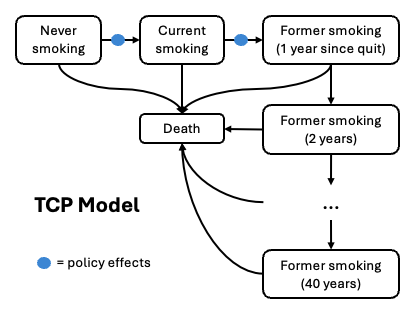About the Tobacco Control Policy Tool
The TCP (Tobacco Control Policy) Tool is an interactive online interface that allows users to explore the potential effects of different tobacco control policies based on simulation models of cigarette smoking. Results are available for each of the 50 US states and the District of Columbia for users to examine. The results compare smoking and mortality outcomes under a baseline scenario ('status quo') with those under a user-specified policy scenario. Policy scenarios simulate the potential impact of a specific policy on adult smoking prevalence, the number of life-years gained, and the number of premature smoking-attributable deaths avoided. To make the TCP tool useful to decision-makers, model estimates are presented at the state level with state-specific policy coverage information as the default setting where applicable. Learn about the development of the TCP Tool by viewing our summary slides (PPT) and webinar video.
The Tobacco Control Policy (TCP) Model
The TCP Tool displays results from the TCP Model, which has been used to evaluate different types of tobacco control policies. The effects of cigarette taxes, smoke-free air laws, tobacco control expenditures were examined using the TCP Model v1.0 which was a microsimulation model.1 TCP Model version 2.0 used a US population model to examine graphic health warnings.2 The current TCP Model, version 2.1, uses state-specific population models to evaluate Tobacco 21 policies.3
Policy scenarios are simulated by modifying underlying probabilities of smoking initiation and cessation in the TCP Model. The simulated effects of policies on smoking behaviors draw upon existing research literature and expert opinion. For the baseline 'status quo' scenario, the model assumes that current rates for smoking initiation and cessation among recent birth cohorts remain constant for future birth cohorts. Note that the model only simulates the impact of a policy on smoking behavior, and does not consider the health benefits of reduced secondhand smoke exposure. For more details about the TCP Model, see additional documentation here.
The TCP Model relies on smoking and mortality rates generated by the Cancer Intervention and Surveillance Modeling Network. These probabilities are specific to age, gender, and year of birth. More information about these underlying data can be found at apps.cisnetsmokingparameters.org, on the CISNET Publication Support and Modeling Resources website, and other publications.4-6

References
- Tam J, Levy DT, Jeon J, Clarke J, Gilkeson S, Hall T, Feuer EJ, Holford TR, Meza R. Projecting the effects of tobacco control policies in the USA through microsimulation: a study protocol. BMJ Open 2018;8:e019169. doi: 10.1136/bmjopen-2017-019169. [BMJ Open]
- Tam J, Jeon J, Thrasher JF, Hammond D, Holford TR, Levy DT, Meza R. Estimated Prevalence of Smoking and Smoking-Attributable Mortality Associated with Graphic Health Warnings on Cigarette Packages in the US From 2022 to 2100. JAMA Health Forum 2021;2(9), e212852. doi:10.1001/jamahealthforum.2021.2852 [JAMA Health Forum]
- Tam J, Crippen A, Friedman A, Jeon, J, Colston DC, Fleischer NL, Levy DT, Holford TR, Meza R. US Tobacco 21 policies and potential mortality reductions by state. JAMA Health Forum 2024;In Press.[JAMA Health Forum]
- Holford TR, Meza R, McKay LA, Clarke L, Racine B, Meza R, Land S, Jeon J, Feuer EJ. Patterns of birth cohort-specific smoking histories, 1965-2009. Am J Prev Med 2014;46(2):e31-7. [PubMed]
- Jeon J, Holford TR, Levy DT, Feuer EJ, Cao P, Tam J, Clarke L, Clarke J, Kong CY, Meza R. Smoking and lung cancer mortality in the United States from 2015 to 2065: a comparative modeling approach Ann Intern Med 2018;169(10):684-693. [Ann Intern Med]
- Holford TR, McKay L, Jeon J, Tam J, Cao P, Fleischer NL, Levy DT, Meza R. Smoking histories by state in the US. Am J Prev Med. 2023;64(4):s42–s52. [Am J Prev Med]
